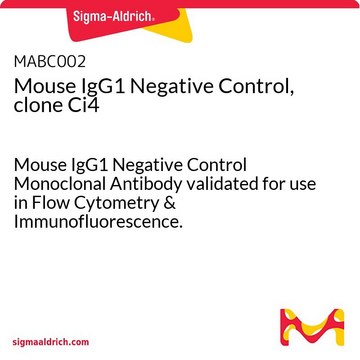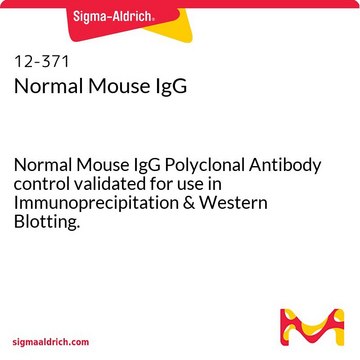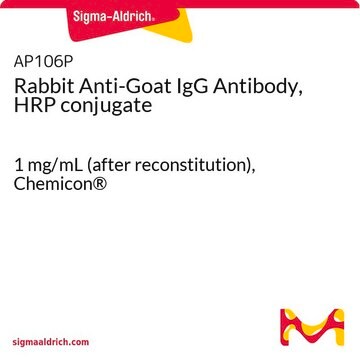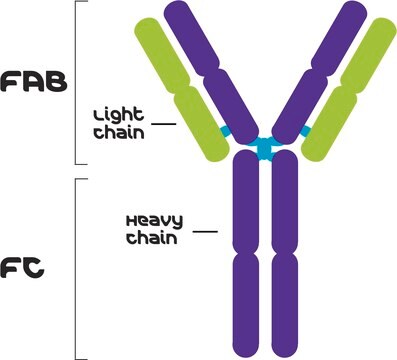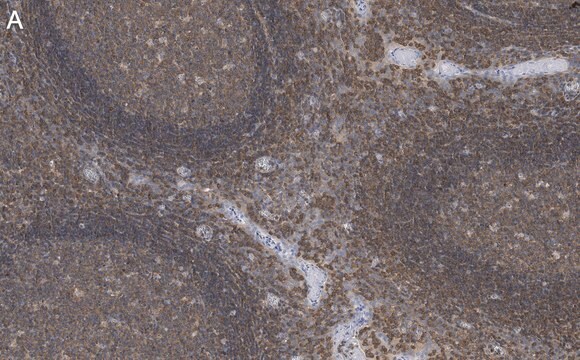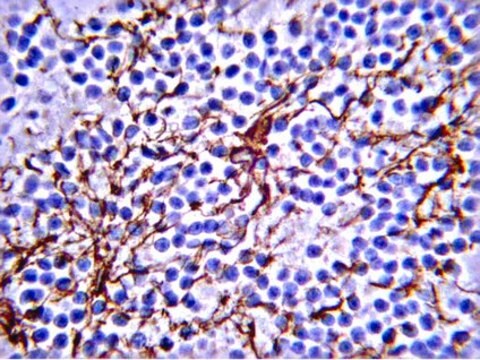CBL610
Mouse IgG1 Negative Control Antibody, clone 1E2.2
clone 1E2.2, 1 mg/mL, Chemicon®
Iniciar sesiónpara Ver la Fijación de precios por contrato y de la organización
About This Item
Código UNSPSC:
12352203
eCl@ss:
32160702
NACRES:
NA.42
Productos recomendados
origen biológico
mouse
Nivel de calidad
forma del anticuerpo
purified immunoglobulin
clon
1E2.2, monoclonal
fabricante / nombre comercial
Chemicon®
concentración
1 mg/mL
técnicas
flow cytometry: suitable
isotipo
IgG1κ
Condiciones de envío
wet ice
modificación del objetivo postraduccional
unmodified
Descripción general
Immunoglobulin G (IgG), is one of the most abundant proteins in human serum with normal levels between 8-17 mg/mL in adult blood. IgG is important for our defense against microorganisms and the molecules are produced by B lymphocytes as a part of our adaptive immune response. The IgG molecule has two separate functions; to bind to the pathogen that elicited the response and to recruit other cells and molecules to destroy the antigen. The variability of the IgG pool is generated by somatic recombination and the number of specificities in an individual at a given time point is estimated to be 1011 variants.
Especificidad
This isotype control shows negligible cross-reactivity with human cell surface antigens on tissue sections or in cellular preparations. It therefore enables the estimation of non-specific binding of mouse monoclonals to cell surface antigens.
Aplicación
Mouse IgG1 Negative Control Monoclonal Antibody validated for use in Flow Cytometry.
Research Category
Secondary & Control Antibodies
Secondary & Control Antibodies
Research Sub Category
Epitope Tags
Epitope Tags
Calidad
Evaluated by Flow Cytometry in HeLa cells.
Flow Cytometry Analysis: 2 µg of this antibody was used as a Mouse IgG1 Negative Control in staining of HeLa cells.
Flow Cytometry Analysis: 2 µg of this antibody was used as a Mouse IgG1 Negative Control in staining of HeLa cells.
Ligadura / enlace
Replaces: CBL600
Forma física
Format: Purified
Protein G
Purified mouse monoclonal IgG1κ in buffer containing 0.1 M Tris-Glycine (pH 7.4), 150 mM NaCl with 0.05% sodium azide.
Almacenamiento y estabilidad
Stable for 1 year at 2-8°C from date of receipt.
Nota de análisis
Control
HeLa cells
HeLa cells
Información legal
CHEMICON is a registered trademark of Merck KGaA, Darmstadt, Germany
Cláusula de descargo de responsabilidad
Minimum order quantity required to qualify. Unless otherwise stated in our catalog or other company documentation accompanying the product(s), our products are intended for research use only and are not to be used for any other purpose, which includes but is not limited to, unauthorized commercial uses, in vitro diagnostic uses, ex vivo or in vivo therapeutic uses or any type of consumption or application to humans or animals.
Código de clase de almacenamiento
12 - Non Combustible Liquids
Clase de riesgo para el agua (WGK)
WGK 1
Punto de inflamabilidad (°F)
Not applicable
Punto de inflamabilidad (°C)
Not applicable
Certificados de análisis (COA)
Busque Certificados de análisis (COA) introduciendo el número de lote del producto. Los números de lote se encuentran en la etiqueta del producto después de las palabras «Lot» o «Batch»
¿Ya tiene este producto?
Encuentre la documentación para los productos que ha comprado recientemente en la Biblioteca de documentos.
Los clientes también vieron
Paul D Madge et al.
Scientific reports, 6, 36012-36012 (2016-11-04)
Siglec-2 undergoes constitutive endocytosis and is a drug target for autoimmune diseases and B cell-derived malignancies, including hairy cell leukaemia, marginal zone lymphoma, chronic lymphocytic leukaemia and non-Hodgkin's lymphoma (NHL). An alternative to current antibody-based therapies is the use of
Tianfu Wang et al.
Cell death & disease, 11(7), 598-598 (2020-08-01)
Osteoarthritis (OA) is a joint disease that causes great pain to patients and imposes a tremendous burden on the world's medical resources. Regulatory noncoding RNAs, including circular RNAs (circRNAs) and microRNAs (miRNAs), play an important role in OA progression. Here
Tiffany R Frey et al.
Journal of virology, 94(7) (2020-01-17)
Lytic activation from latency is a key transition point in the life cycle of herpesviruses. Epstein-Barr virus (EBV) is a human herpesvirus that can cause lymphomas, epithelial cancers, and other diseases, most of which require the lytic cycle. While the
Tiffany R Frey et al.
Frontiers in microbiology, 12, 708404-708404 (2021-08-27)
Human gammaherpesviruses Epstein-Barr virus (EBV) and Kaposi's sarcoma-associated herpesvirus (KSHV) persist as life-long infections alternating between latency and lytic replication. Human endogenous retroviruses (HERVs), via integration into the host genome, represent genetic remnants of ancient retroviral infections. Both show similar
Florian Bellutti et al.
Journal of virology, 89(3), 1608-1627 (2014-11-21)
Adenoviruses encode a set of highly abundant microRNAs (mivaRNAs), which are generated by Dicer-mediated cleavage of the larger noncoding virus-associated RNAs (VA RNAs) I and II. We performed deep RNA sequencing to thoroughly investigate the relative abundance of individual single
Nuestro equipo de científicos tiene experiencia en todas las áreas de investigación: Ciencias de la vida, Ciencia de los materiales, Síntesis química, Cromatografía, Analítica y muchas otras.
Póngase en contacto con el Servicio técnico
